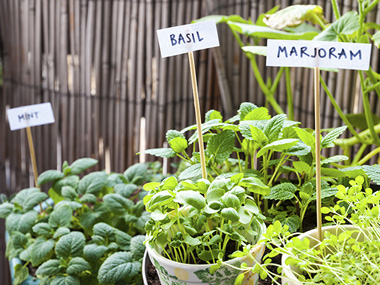LIVE WELL
Have a Healthy Hobby: Plant a Potted Garden
by XSport - April 2015, Edition 14
When you finally get a break in the weather after a long winter, it’s natural to want to get outside, move that body, and reap the health benefits of fresh air and sunshine.
Planting a veggie garden is a hobby that connects you with nature and makes the most of your spare time—results are edible! Short on space? Containers are the answer.
Here are three ways to use garden pots to grow healthy, delicious veggies and herbs you can pick from your own backyard or porch, even if you’ve never tried out your green thumb. You’ll have the added benefit of lifting, bending, digging and stretching that comes with gardening. Not to mention the extra beauty out your back door!
1. Start with a couple of very large pots.
Try for 18” and make sure they have drainage holes in the bottom. You’ll need to water any day it doesn’t rain, but you also need to prevent overwatering in the containers. Fill with potting soil (it costs more than topsoil, but it’s specially blended to support the needs of container plants, so it’s worth it). You can start seeds in one pot any time now, for cool weather leafy plants. Consider nutrient-rich spinach and arugula. You’ll have baby greens for salad in May! Save half your seeds for the fall garden.
In the other pot, plant a small heirloom or patio tomato plant after the danger of frost is gone. Waiting until Memorial Day weekend is a safe bet. Select a plant that has grown to a strong 8 – 12" in a greenhouse… maybe it will have a few flowers on it as well. Finally, stake it up or put a tomato cage around it that fits inside the pot. As it grow, support the branches and fruits.
By the 4th of July, you’ll be starting to get a tomato or two, but your pot of greens will be expired—they don’t like it too hot. You can plant some annual flowers on sale for a pop of color in that pot until mid-August… then plant the other batch of those seeds. The leafy green seedlings will mature in the fall, for a second harvest of baby greens followed by another round of full grown spinach and arugula.
2. Focus on herbs.
You can set up with two large pots again, or use a variety of smaller containers. Fill them with potting soil and purchase small potted plants to transplant around Memorial Day.
Group similar plant types together to help you control the watering needs and growth habits of your herbs. Some plants have more leaves and tall, tender stems—Sweet Basil and Flat Leaf Parsley for example. They go well together in a planting because they both like sun and plenty of water. The woodier stems and smaller leaves of certain Mediterranean origin don’t need as much water and don’t grow as big. Examples would be Rosemary and Lavender.
Beware of some herb plants that are known to grow large, spread, and even become invasive. Mint is notorious for this—it’s fun to grow your own spearmint for mojitos and Asian food, just don’t plant it in a pot with another herb it’s likely to overtake, like delicate tarragon. All in all, your potted herb garden will give you access to tasty flavors for home cooked food every day. Even better, the more you snip, the more they grow!
3. Create a flavor garden.
You can mix your pot sizes, timing and plantings to grow a perfect mix of ingredients around a flavor profile you love. Once again start with potting soil inside your chosen containers, making sure they all have adequate drainage. Then do a little thinking on what you like to eat, and get specific with your selections of plants.
You can create a pasta sauce garden by planting one potted tomato, and a couple of herb pots featuring oregano, basil, parsley, and thyme. Or, you might choose an Asian-inspired mix, with lemon grass, Thai basil and cilantro, plus a bush cucumber and pot of green onions. Or baby bok choi and Japanese eggplant.
Other ideas for flavor gardens include a salsa garden (tomato, cilantro, Mexican oregano, jalapeno, green onion), Americana (baby carrots, spring onions, new potatoes, parsley, sage, rosemary, thyme) or Salad (lettuce, spinach, radishes, baby carrots, green onions, bush bell pepper or bush cucumber, patio tomato).